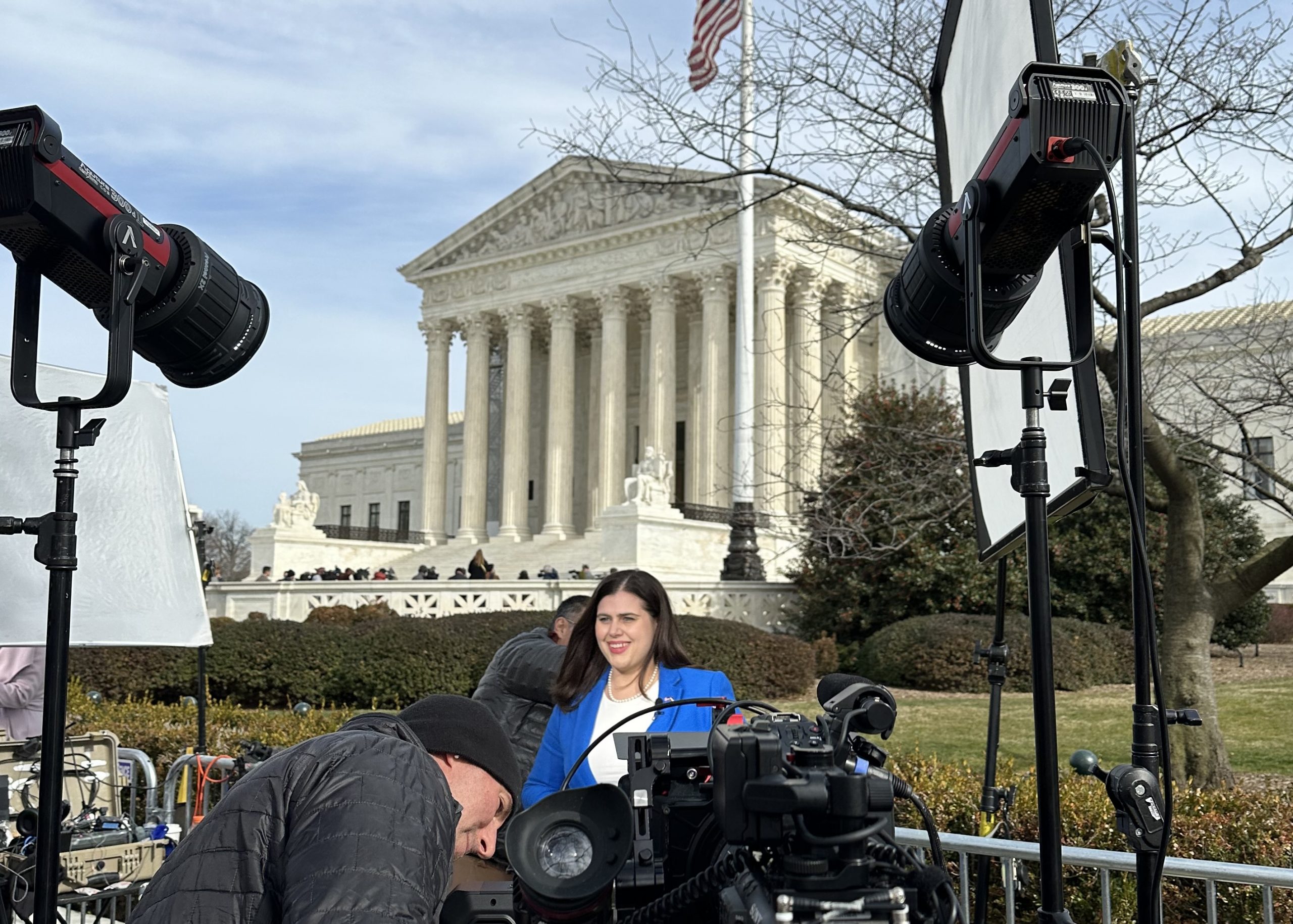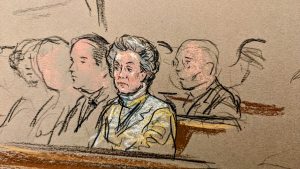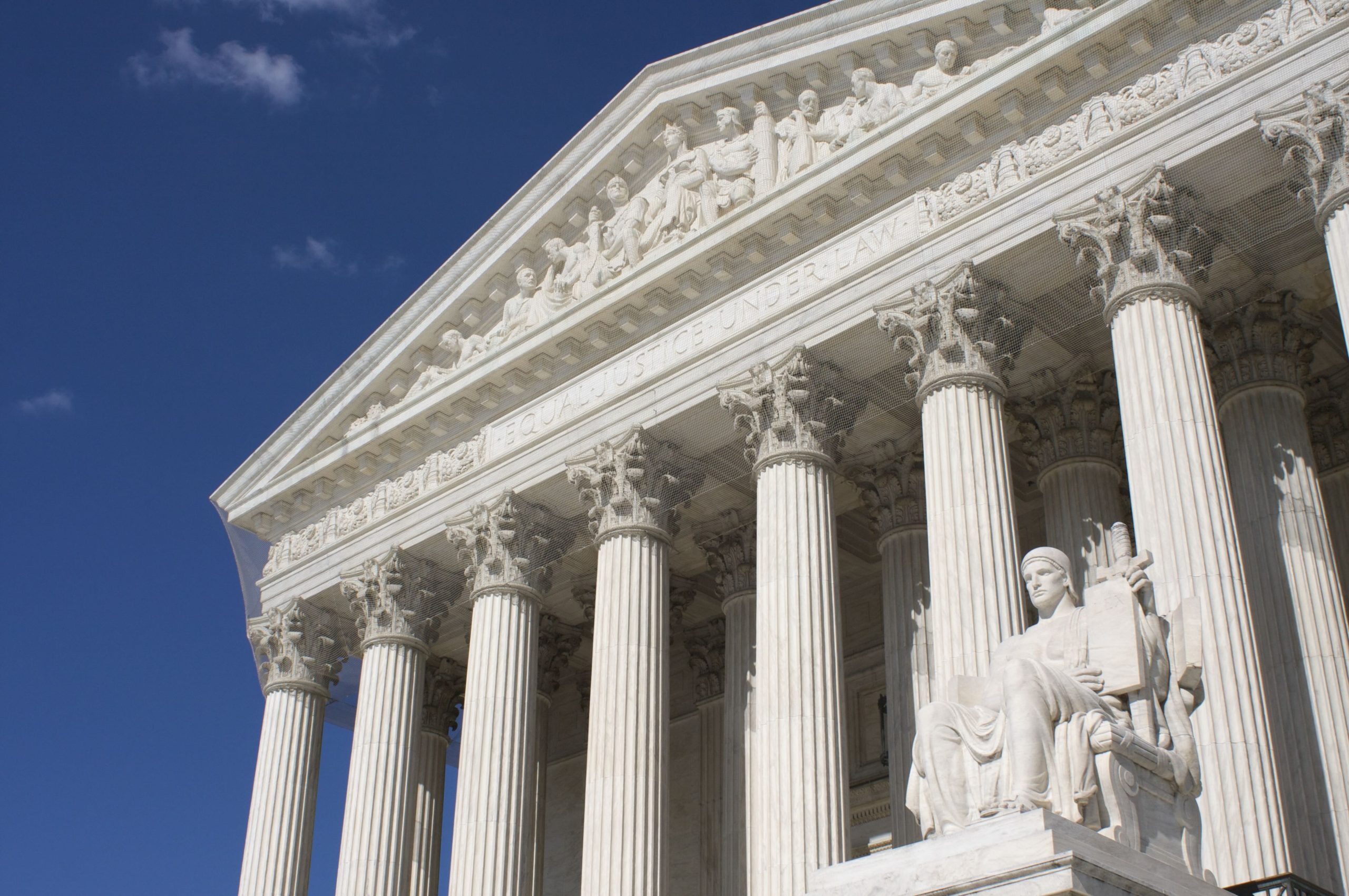A packed courtroom for the Trump ballot case
VIEW FROM THE COURT
on Feb 8, 2024
at 5:41 pm
Colorado Secretary of State Jena Griswold outside of the Supreme Court on Thursday. (Katie Barlow)
We have known since last week (thanks to reporting by Maggie Haberman and Alan Feuer in The New York Times) that the big Republican elephant will not be in the room today when the U.S. Supreme Court takes the bench in Trump v. Anderson, about whether the Colorado Supreme Court erred in excluding former President Donald Trump from the state’s 2024 presidential primary ballot.
Trump is reportedly starting the day at Mar-A-Lago, then heading to Nevada this evening for its Republican caucuses. Given the former president’s recent headline-generating behavior inside and outside other courtrooms, there seems to be a collective sigh of relief here at the Marble Palace.
There will be a packed courtroom, though. The first notable I notice upon entering at 9:30 a.m. is Sen. Mike Lee, R-Utah, a member of the Judiciary Committee and someone who has endorsed Trump. He is in the public gallery. Arriving a few minutes later is Jason Miller, a longtime Trump political adviser.
The only Democratic member of Congress I notice here today is Rep. Jamie Raskin, D-Md., a member of the select committee that investigated the events of Jan. 6, 2021, and whose report was admitted into evidence by the Colorado trial court. (I later see him comment on CNN that he was surprised by the court’s sudden respect for Congress over the states.)
Norma Anderson, one of the Colorado voters who sued Trump last year, in the courtroom on Thursday. (William Hennessy)
Seated near Raskin in 91-year-old Norma Anderson, a former Colorado legislator who is the lead plaintiff in the effort to exclude Trump from that state’s ballot. As The Washington Post reported last week, she keeps a pocket copy of the Constitution in her purse, which is dog-earred to the page with the 14th Amendment, whose Section 3 bars those who have sworn an oath to the Constitution from office if they have engaged in insurrection.
Anderson, a Republican, was the first female majority leader in the Colorado senate, an achievement that puts her in a class with the late Justice Sandra Day O’Connor, who had the same first in the Arizona state senate.
If Anderson wanted to, she could engage another spectator in her row with some lively debate on the issues in the case. Professor Seth Barrett Tillman, a New York native who teaches law at Maynooth University School of Law in Kildare, Ireland, has been thinking and writing about some of the issues around Section 3 since at least 2014, including his view that the president is not “an officer of the United States.”
Tillman filed an amicus brief in support of Trump with Professor Josh Blackman of South Texas College of Law Houston. Blackman has taken a seat in the bar section not far from reporters in the press section. Blackman and Tillman have been writing and appearing widely to debate the many fine points of the issues in recent weeks. (Blackman was at the Heritage Foundation on Wednesday for a panel and on C-SPAN early this morning.)
Two scholars who are not here are William Baude of the University of Chicago law school and Michael Stokes Paulsen of the University of St. Thomas in St. Paul. Minn., whose article “The Sweep and Force of Section Three” turbocharged the disqualification debate when it was posted online last August. (It is listed on the Social Science Research Network as “forthcoming” this year in the University of Pennsylvania Law Review.)
Baude and Paulsen argue in their paper that Trump engaged in insurrection over his efforts to deny the 2020 election results and encourage the Jan. 6 assault on the U.S. Capitol. They also argue that Section 3 is self-executing and does not require implementing legislation by Congress. Their paper is all over the briefs in this case, and they will get a mention during the argument.
Three spouses of justices enter the guest box: Ashley Kavanaugh, Jesse Barrett, and Patrick Jackson.
Finally, U.S. Solicitor General Elizabeth Prelogar and some of her office’s members take their usual seats at the front of the bar section. I wondered whether they would appear, given that the United States has stayed far away from this case. But it would be unusual for the SG’s office not to be present for the delivery of opinions and to simply observe such a high-profile argument. Seated separately in the bar section is Michael Dreeben, an SG’s office veteran who is working for Special Counsel Jack Smith on the criminal prosecution of Trump over Jan. 6.
When the justices take the bench at 10 a.m., Chief Justice John Roberts says, “Before we turn to the case this morning, the court has two opinions to announce.”
Justice Neil Gorsuch provides a (typically) concise summary of the unanimous opinion in Department of Agriculture v. Kirtz, while Justice Sonia Sotomayor goes on a little longer on Murray v. UBS Securities. Nobody here today seems to be on pins and needles over whether a consumer may sue a federal agency for defying the Fair Credit Reporting Act or about the fine points of whistleblower protections under the Sarbanes-Oxley Act.
The livestream does not air these opinion announcements (except for one time last term when it accidentally did so before an argument), and some home listeners are no doubt wondering why the argument does not begin until 10:08.
As Amy Howe wrote in her coverage of the argument, the justices pretty quickly revealed that they were not going to debate whether Trump engaged in insurrection but would focus on a handful of the other questions. That includes the role of Griffin’s Case, an 1869 decision by Chief Justice Salmon Chase, acting as a circuit judge, that it would be infeasible to decide who was covered by the disqualification clause without a legal process passed by Congress.
“Professor Baude and Professor Paulson criticized Griffin’s Case very sharply,” says Jonathan Mitchell, the lawyer arguing for Trump and making the point that the case was in tension with the ability of Congress to lift any disqualification by a two-thirds vote.
“Then I must be right,” Justice Elena Kagan, who had asked Mitchell about the tension between two perspectives on Congress’s powers, says to laughter.
When the cases involving Texas’s S.B. 8 restrictive abortion law were argued in the fall of 2021, Kagan had indirectly referred to Mitchell as one of the “geniuses” who helped devise a way to protect that law from federal constitutional review. She did not mean it as a compliment. Mitchell was in the courtroom that day, arguing a small part of the two related cases. But Kagan has fairly civil interactions with Mitchell today.
Kavanaugh, meanwhile, returns several times to the 1869 case.
“Griffin’s Case is also relevant to trying to figure out what the original public meaning of Section 3 of the Fourteenth Amendment is,” he says. “It’s by the Chief Justice of the United States a year after the Fourteenth Amendment. That seems to me highly probative of what the meaning or understanding of that language, otherwise elusive language, is.”
There is debate over “officer of the United States” and “Term Limits,” which the chief justice asks Mitchell to clarify that he’s referring to a 1995 Supreme Court decision, U.S. Term Limits v. Thornton, which barred the states from adding additional qualifications to federal offices. Some justices appear to be looking to that case as a hook to overrule the Colorado Supreme Court.
When Jason Murray, the lawyer representing the Colorado voters seeking to disqualify Trump, takes the lectern, it seems clear that he faces an uphill climb.
Kagan puts it bluntly, or as she says, “Maybe put most baldly, I think that the question that you have to confront is why a single state should decide who gets to be president of the United States. In other words, you know, this question of whether a former president is disqualified for insurrection to be president again is, you know, just say it, it sounds awfully national to me. So whatever means there are to enforce it would suggest that they have to be federal, national means.”
And by the time Colorado Solicitor General Shannon Stevenson gets her 10 minutes of time to represent Secretary of State Jena Griswold, who is seated in the front row of the public section, the justices can barely feign any interest in her argument that the state has an interest and power under the Electors Clause to resolve any challenge to the listing of a candidate on a primary ballot before state voters cast their ballots.
Justice Samuel Alito steps in during an awkward pause to ask her a question, and he is the only one with a query for her during the seriatim round of her time.
“We have been told that if what Colorado did here is sustained, other states are going to retaliate and they are going to potentially exclude another candidate from the ballot,” Alito says. “What about that situation?”
Stevenson says that “we have to have faith in our system that people will follow their election processes appropriately, that they will take realistic views of what insurrection is under the Fourteenth Amendment. Courts will review those decisions. This Court may review some of them. But I don’t think that this Court should take those threats too seriously in its resolution of this case.”
Alito does not seem too reassured. A few minutes later, Roberts declares that the case is submitted. At some point soon, they will cast their votes on the case and likely effectively decide whether a leading contender for president will be on the ballots for millions of voters.







